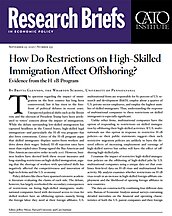The question regarding the impact of immigration on the host country has long been controversial, but it has risen to the forefront of political debates in recent years. Unexpected political shifts such as the Brexit vote and the election of President Trump have been attributed to voters’ concern about the impact of immigration. While the debate surrounding low-skilled immigration has captured headlines in the United States, high-skilled legal immigration—and particularly the H‑1B visa program—has also been contentious. Critics of the H‑1B program argue that skilled immigrants displace native-born workers and drive down their wages. Indeed, H‑1B rejection rates have more than tripled since Trump signed the Buy American and Hire American executive order in early 2017. However, business leaders have decried both these recent measures and long-standing restrictions on high-skilled immigration, arguing that the shortage of workers with specialized skills has negatively affected the competitiveness and innovation of high-tech firms and the U.S. economy.
Policy debates like these have spawned extensive academic literature evaluating the claims of each side. The debate, however, has largely overlooked the secondary consequences of restrictions on hiring high-skilled immigrants: multinational companies faced with decreased access to visas for skilled workers have an offshoring option—namely, hiring the foreign labor they need at their foreign affiliates. U.S. multinational firms are responsible for 80 percent of U.S. research and development (R&D), employ about a quarter of U.S. private-sector employees, and employ the highest number of skilled immigrants. Thus, understanding the response of multinational companies to these restrictions on skilled immigrants is especially significant.
Unlike other firms, multinational companies have the option of responding to restrictions on skilled immigration by offshoring their high-skilled activities. If U.S. multinationals use this option in response to restrictive H‑1B policies—as their public statements suggest—then such restrictive migration policies are unlikely to have the desired effects of increasing employment and earnings of high-skilled natives but rather will have the effect of offshoring high-skilled jobs.
I examine the impact of restrictive high-skilled immigration policies on the offshoring of high-skilled jobs by U.S. multinational companies using a unique data set that combines firm-level data on H‑1B visas and multinational firm activity. My analysis examines whether restrictions on H‑1B visas result in an increase in high-skilled foreign-affiliate employment and the likelihood of opening foreign affiliates in new countries.
The data are constructed by combining four different data sets: Bureau of Economic Analysis annual surveys containing detailed microdata on the financial and operating characteristics of both the U.S. parent companies and their foreign affiliates; H‑1B visa microdata; Labor Condition Application (LCA) data; and U.S. Patent and Trademark Office patent data. These data allow me to measure exactly how constrained each firm was as the cap grew more restrictive over time by comparing—at the firm level—LCA requests (demand) and issued H‑1B visas (realized supply) and how their foreign-affiliate employment in each country responded to these constraints.
I analyze the impact of restrictions on H‑1B visas on foreign-affiliate activity using two identification strategies. The first exploits the 2004 drop in the H‑1B visa cap, while the second exploits randomized variations in firm-level excess demand from the H‑1B visa lotteries in high-demand years. Both strategies yield the same result: restrictions on H‑1B immigration caused increases in foreign-affiliate activity as U.S. multinationals both employed more people at their existing foreign affiliates and opened foreign affiliates in new countries. The effects are concentrated among highly H‑1B-dependent firms and R&D‑intensive firms operating in offshorable services sectors. The expansion of foreign-affiliate employment has been largely concentrated in three countries: China, India, and Canada.
These findings support the hypothesis that restrictions on high-skilled immigration cause the offshoring of skilled jobs. While high-profile cases—such as Microsoft’s decision to open an R&D foreign affiliate in Vancouver—have suggested that restricting skilled-immigration flows could lead to the offshoring of skilled jobs, this is the first rigorous empirical work examining whether this claim is indeed true. The findings also have important policy implications; the offshoring of jobs appears to be an unforeseen consequence of restricting skilled-immigration flows. Even if H‑1B immigrants displace some native workers, policymakers concerned about the loss of native jobs should consider that policies aimed at reducing immigration actually encourage firms to offshore jobs abroad.
NOTE:
This research brief is based on Britta Glennon, “How Do Restrictions on High-Skilled Immigration Affect Offshoring? Evidence from the H‑1B Program,” NBER Working Paper no. 27538, July 2020, https://www.nber.org/papers/w27538.

This work is licensed under a Creative Commons Attribution-NonCommercial-ShareAlike 4.0 International License.
